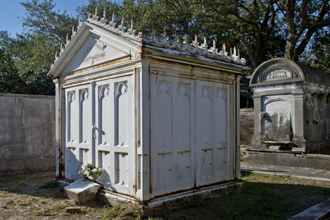Sepulchral splendor in New Orleans
At cemeteries across New Orleans, All Saints' Day (Nov. 1) marks the culmination of a period of cleaning and sprucing up family burial grounds. Heather Knight is teaching a group of first-year Tulane students to look at these unique, aboveground tombs with fresh eyes.

The Karstendiek tomb in Lafayette Cemetery No. 1 in uptown New Orleans is a rare example of a pre-fabricated cast-iron tomb. With Gothic Revival elements, including delicate pintelles and tri-foil arches, the tomb was a prop model for the film Interview With the Vampire. (Photo by Paula Burch-Celentano)
“Whatever architectural style was in vogue at the time of building a tomb, that is the style we see, whether it's Greek Revival, Gothic Revival or Italianate,” says Knight, an adjunct assistant professor in the School of Architecture.
Among the cemeteries the students explore is Metairie Cemetery, the final resting place for more kings and queens of Carnival than anywhere else, says Knight. In Lafayette Cemetery No. 1, across from Commander's Palace restaurant, students see a rare, cast-iron Gothic Revival tomb. Knight points out iconography that symbolizes death a broken rose stem, an hourglass with wings, torches turned upside down.
An architectural conservator, Knight has a master's degree in preservation studies from the Tulane School of Architecture. She operates the restoration business, Chaux Vive Architectural Conservation and Consulting, whose name refers to “hot lime,” a substance used to make whitewash and plaster for tombs and historic homes. Knight also is on the board of Save Our Cemeteries.
In the TIDES class, Knight introduces students to the Southeastern Architectural Archive at Tulane, where primary sources such as 19th-century cemetery maps, architects' drawings with tomb specifications and a wrought-iron cross with zinc rosettes are housed.
Knight hopes that the students will appreciate the work of Creole craftsmen who for generations have fashioned New Orleans' intricate burial places.
“When you preserve historic tombs,” she says, “you're not only preserving the architectural details, but they represent the craftsman's hands that labored over them, the brickwork, the historic pigments, the labor of stone masons.”
